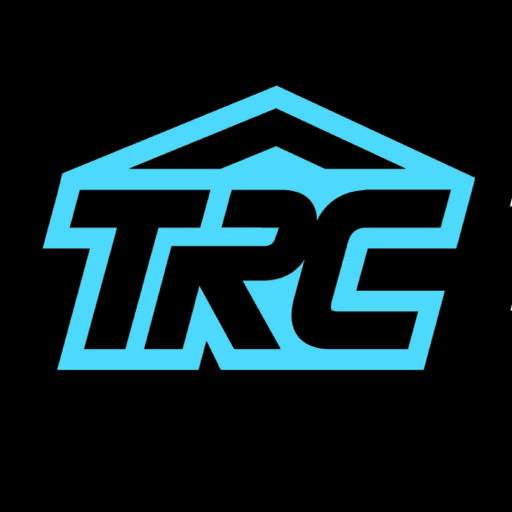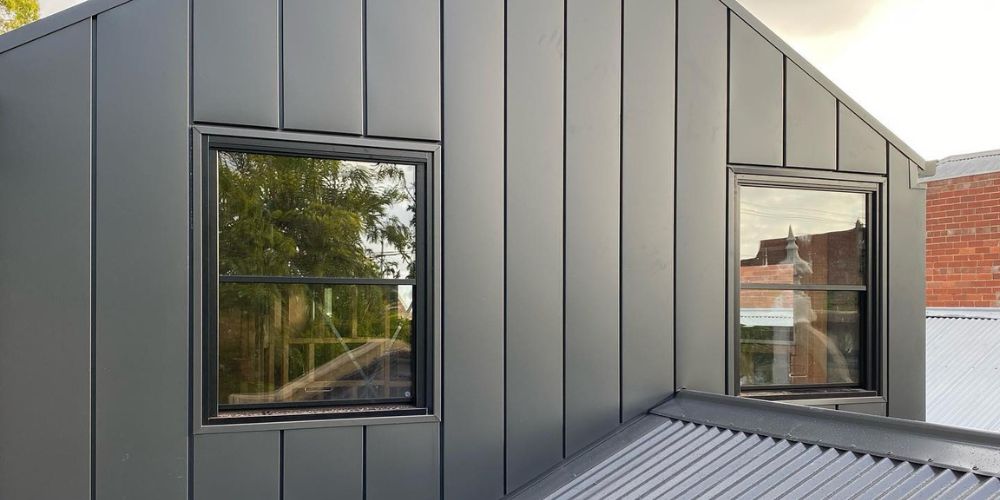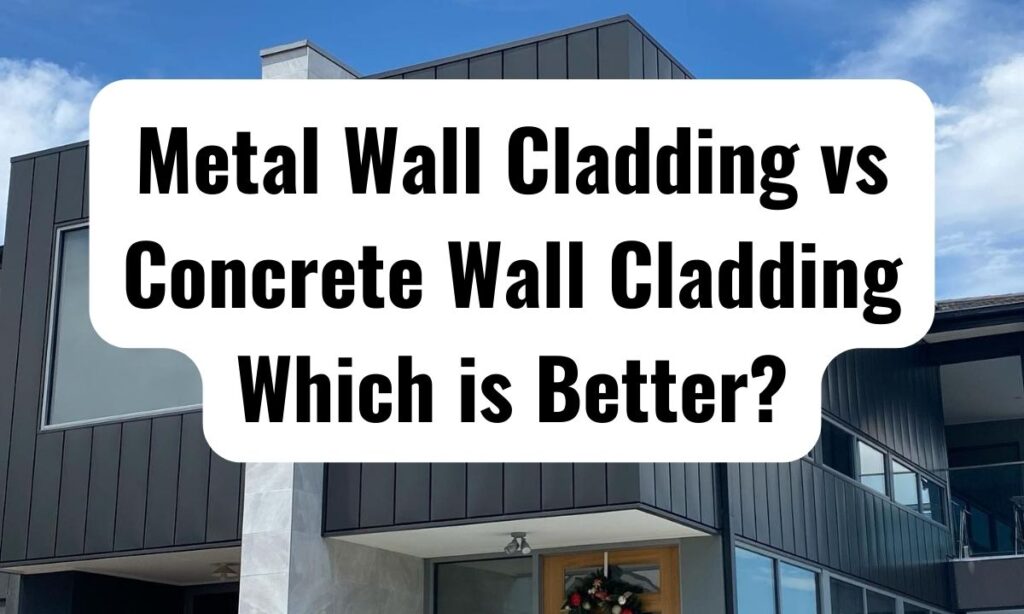Metal wall cladding vs concrete wall cladding - Everything you need to know
Cladding systems comprise two interconnected components: the wall system (such as lightweight timber framing) and the cladding layers. Cladding is a non-loadbearing skin or coating affixed to the outside walls. Its primary function is to protect a structure from water and weather impacts; other parts can include sound, thermal insulation, and fire resistance. The cladding you choose has a considerable effect on your home’s environmental performance, cost, aesthetic appeal, and property value.
You may obtain optimum physical performance and aesthetics by selecting cladding materials specific to an elevation or exposure. There are many types of cladding designs and options in the market.
Two of the most preferred wall cladding design options among our clients are metal walls and concrete cladding. This depends upon homeowners’ preference on how they would want their exterior designs to look. But how do these two differ?
Let us discuss with you on a quick walk-through the main fundamental difference between the metal wall and concrete wall cladding.

Lance Mathews
In This Article

What is a metal wall cladding?
Metal cladding is a sort of metal exterior cladding. While it is made of a different material, it serves the same purpose as practically all other types of cladding: it protects the exterior or interior of a building. Architectural cladding can be used to improve a structure’s appearance and provide structural protection. Metal cladding can be highly useful for both reasons. The metal, in general, is quite robust and durable. Its extensive range of types and finishes allows for aesthetic versatility. Unlike most other types of cladding, metal cladding can also be used for roofing.
Materials Commonly used for Metal Wall Cladding:
- Galvanised steel
- Aluminium
- Titanium
- Zinc
- Coper
- Brass
The Pros and Cons of Using a Metal Wall Cladding
Pros
Versatility
Metal panels can be used for external and interior cladding. Heavy materials such as bricks and concrete can easily replace metal wall panels. It can be used to cover both interior and exterior walls. Metal roof panels are also excellent for the roof deck. Metal panelling and lining can be combined with other materials, such as vinyl and concrete, to provide further protection.
Regarding interior design, many builders nowadays prefer metal panels over traditional materials like drywall or wood. This is because metal panel ceilings and wall surfaces are sturdy, durable, and visually appealing. And, because metal panels may be constructed from various materials and textures, the number of looks that can be created for a building grows exponentially.
Durability
One of the primary benefits of metal cladding panels is their durability, mainly when used externally as wall cladding, roof decking, or trim. Metal panelled cladding is durable and resistant to water damage, electrochemical reactions, and corrosion. Metal cladding panels are also far more resistant to damage caused by impacts like hail or other flying items than materials such as drywall, wood, and composites. This is one of the explanations why metal panels are commonly used for exterior industrial cladding. Metal panels have exceptionally extended longevity and require little to no maintenance.
Fire resistance
Metal is usually pretty fire resistant, but it is a good idea to contact manufacturers about the fire-resistance rating needs of your cladding. To minimise unintended outcomes, it is also critical to analyse how metal cladding interacts with other elements within a building shell.
Easy to Install
Metal cladding is much faster and easier to instal than brick, block, or concrete cladding. It is also a less challenging and time-consuming task. This is only possible because metal panels can be manufactured in large, lightweight sections, allowing a larger area to be covered faster than typical cladding materials. Several metal cladding systems contain particular fastening mechanisms that speed up the process even more.
Sustainable
All varieties of metal cladding include recycled materials to different extents, making them environmentally friendly. They are also easily recyclable because they are made from familiar metals. Overall, this significantly reduces the carbon footprint of any construction.
In this approach, metal cladding panels have numerous advantages and are transforming the way buildings are designed and built. Metal panels will likely become the dominating choice for exterior cladding.
Wide Selection of Styles and Designs
Metal cladding comes in various finishes and styles to complement any architectural style. So, in addition to providing a protective layer, it may also increase the appearance and value of a structure, whether residential, industrial, or commercial. You can select various textures, colours, designs, forms, and sizes.
Cons
Rusting
To avoid rusting or corrosion, metal cladding sheets are coated. However, once sliced, the edges are typically left uncoated and visible. As a result, these edges may corrode with prolonged contact with moisture. This can result in cladding deterioration and holes.
Noise
Metal cladding comes in various finishes and styles to complement any architectural style. So, in addition to providing a protective layer, it may also increase the appearance and value of a structure, whether residential, industrial, or commercial. You can select various textures, colours, designs, forms, and sizes.
Chalking and Fading
The coating on the metal cladding may begin to fade due to climatic conditions, known as photo-degradation. This can develop due to harsh weather, pollution, wetness, UV lights, salty air, and other factors. Paint deterioration or chalking occurs spontaneously over time as well.
Delamination
For lamination, cladding usually is covered with a polyester layer on top. However, as moisture begins to soak in and cause rust, this lamination layer might start to detach from the metal surface. Even though dye sublimation laminations are now manufactured for long life, the problem persists.
What is a concrete wall cladding?
Concrete cladding can be installed on the inside or outside of a building. It is made of pre-formed concrete (using moulds) into the desired panel shapes or tiles. The concrete is grey if no colouring agents are applied; however, many various colours can be created by mixing colours. If desired, you can add colour to the concrete.
Concrete cladding panels are generally outside-made precast concrete panels used to clad various buildings, such as residential buildings, commercial buildings, hospitals, schools, etc. This cladding panel is composed of solid and other durable concrete. It is placed on the outside and inside of a structure. They improve the building’s visual appeal while also increasing its durability. In some cases, concrete cladding can be built from several materials, such as stone, bricks, and even wood.
The Pros and Cons of Using a Concrete Wall Cladding
Pros
Cost-effective
One of the vastest benefits of putting concrete cladding panels on the outside or interior of a building is that they are quite affordable to instal. Concrete is particularly cost-effective for any building since it provides long-term results at less than other cladding materials.
Low-maintenance
Concrete cladding panels require relatively little care, so you won’t have to worry about frequent maintenance once put. The only maintenance needed for concrete cladding panels is regular cleaning or repainting to increase the aesthetic appeal of the panels.
Rapid construction schemes
Manufacturing occurs concurrently with foundation and frame building, allowing them to be shipped and erected on a just-in-time basis. Panels can be provided with windows and insulation installed at the factory, speeding up the work of the following trades. Early dry envelope enclosing allows follow-on deals to begin sooner.
Waste reduction and material efficiency
Because units are fully developed in the factory, there is barely any waste produced during production. Shipment and installation require little to no packing.
Lifespan and adaptability
Concrete cladding is used to produce long-lasting facades. They can also be dismantled and the panels reconditioned for future use or crushed to generate recyclable aggregate and scrap steel.
Fire Resistance and Sound Proof
Concrete is a sound fire barrier; it just does not burn well. Precast concrete wall panels have a fire-resistance rating of two to four hours. Precast walls are also resistant to chemical fires. Precast wall panels are frequently used as dividers in warehouses to safeguard commodities on the other side of fire-prone regions.
Cons
Expensive Initial Investment
Heavy and complex machines are usually required to install concrete wall cladding, which involves a significant initial expenditure. A considerable scale of precast construction projects must be offered to provide a reasonable return.
Concrete Cladding Handling Challenges
Handling precast concrete requires extreme caution and care. Precast members are typically heavy and massive, making them difficult to handle without harm. Precast members are usually operated by portable or tower cranes.
Modification
Concrete cladding modification feature is limited. Dismantling a concrete cladding structure for renovation will affect the entire property.
Metal vs. concrete cladding-which is better?
The preference between metal and concrete cladding for your home always depends on the exterior look and property necessity. We mentioned above the pros and cons of the two wall cladding types. We always advise our clients with different wall solutions depending on other factors. Every home or property is unique. It has its own needs and limitations considering the location, budget, external factors, etc. We can’t stress enough the importance of having good solid advice from a well-qualified and experienced professional who has your best interest at heart.
How To Choose Your Wall Cladding Types - 4 Things To Consider
Determine your project budget
House restoration projects may be expensive, and if you don’t plan ahead of time, you may spend more than you can afford and jeopardise your financial health. Every homeowner wants to avoid these scenarios, so it’s critical to plan ahead of time and educate yourself before making a final decision.
Installation and texture
Some people are pretty concerned with the final appearance. You should choose your wall covering carefully if you are one of them. There are numerous textures to pick from, but most people can choose one that suits their preferences. If you decide to use light wall cladding, you can attach it to your walls on your own. However, hiring a contractor is recommended because it will save you a lot of time.
Cost-effectiveness
You may be tempted to believe that low-cost cladding materials are a steal. However, low-cost materials may not be the most cost-effective because they may require extensive upkeep.
Help our home withstand harsh climate
There’s no denying it. Australia’s climate conditions establish high criteria for the efficiency of our construction materials. This is something to bear in mind while choosing materials. Products and materials produced in other countries are frequently unfit for purpose. They can’t predict what they’ll be subjected to. Thus they don’t last when used in our local renovations or new projects.
Key Takeaways
Building cladding is an essential component of a building’s envelope and must be carefully selected to guarantee the greatest performance. The primary function of the cladding is to act as a weatherproofing layer, preventing outside factors such as rain, wind, and dust from affecting the interior structure of the walls. It’s also an important aspect of a building’s aesthetics: it’s the visible exterior skin.
Choosing between metal and concrete wall cladding always comes down to preference and the structural needs of your property. We always advise consulting a roofing and cladding expert before you choose a material, but in general, the rule of thumb is that metal is usually preferable when aesthetics are more important and concrete is better for structural purposes. No matter what you choose, it’s essential to get the advice of a contractor to help determine your needs.

